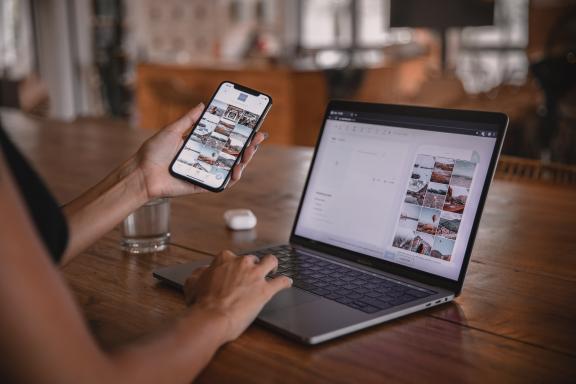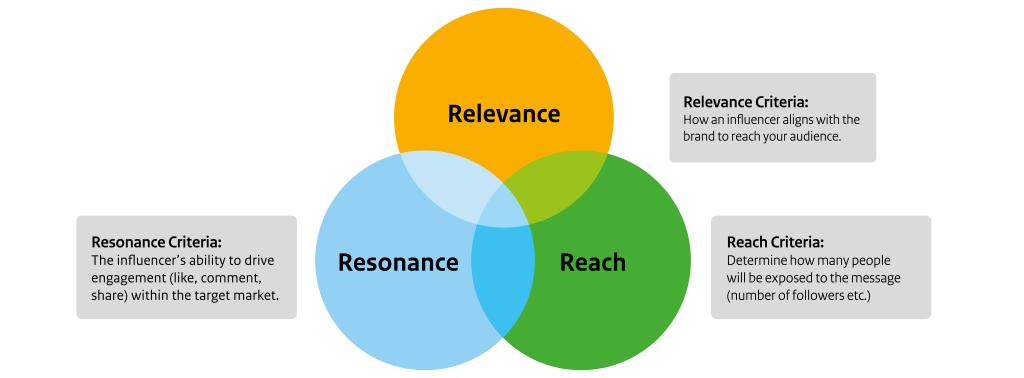
How to work with influencers
Influencer marketing is widely used today by big and small brands in many sectors. Its growth is mainly being driven by younger consumers (Gen Y and Gen Z) who relate to influencers who inspire them. They trust influencers and are engaged, loyal audiences. Creating an influencer campaign is essential in today’s digital marketing arena. Tourism businesses that develop strong relationships with relevant influencers can generate awareness and build trust amongst new audiences.
Contents of this page
1. What are influencers?
Influencers are marketers who work exclusively in the social media and online environment. They create content and have a dedicated following on their social media channels. Travel influencers focus on making, sharing and promoting content related to travel and tourism. Influencer marketing is a fast-moving and constantly evolving environment.
Influencers are known by many different names. These include:
- Influencer;
- Blogger;
- Instagrammer;
- YouTuber or vlogger;
- Digital creator; and
- Content creator.
Most travel influencers use more than 1 social media platform, and many have their own websites as well. The content they produce is text-based, image-based and/or video-based. Most of them produce a range of content for the different platforms they use.
Table 1: Content produced by influencers
|
Content |
Description |
|
Blogs |
A blog is an article written in a personal, conversational style about a topic the blogger is very familiar with. Blogs are usually posted on the blogger’s own website, their client’s website or both. This type of content has been used to generate awareness of a destination and inspire travellers for many years, and it continues to be of value to tourist boards and tour operators, which use it on their websites.
Social media accounts can be used to link to blogs and drive traffic to the client’s website. Well-written blogs that make effective use of keywords generate good SEO (search engine optimisation) and can be used for a long time are referred to as ‘evergreen content’. Over time, they can be updated and reposted, and relevant keywords may be added. |
|
Video blogs (or vlogs) |
Video blogs have a similar function to written blogs and are usually posted on YouTube. They also have a long shelf life. Today, consumers increasingly prefer watching videos to reading written content, so video blogs/vlogs have become more popular. |
|
Social media content |
On social media platforms, content is usually referred to as posts. On X (formerly Twitter), posts are also called tweets. Posts can be images, text or videos. Social media channels include Facebook, Instagram, X/Twitter (Twitter was rebranded as X in July 2023), LinkedIn, TikTok and Pinterest. Hashtags (#) are user-generated search terms that can be used to find similar posts and new content.
In the travel industry, Instagram is the most widely used social media platform for influencer campaigns. TikTok – where influencers post videos on their profiles in a similar way to Instagram – is also becoming a more popular platform for travel influencer content. It has a much younger demographic than Instagram, with Gen Z (aged up to 27) being the predominant demographic. Already influential, Gen Z-ers are becoming more important as travel consumers and spenders as they enter the workforce.
On Instagram, the process of posting content works as follows:
Posts are images or videos (reels) accompanied by short, inspirational messages. Followers are drawn to the posts on the influencers’ profile pages. Influencers tag the businesses they are working with. Stories are images or videos designed to be short-term and informal ‘in the moment’ pieces. Unless they are pinned as a highlight, they disappear after 24 hours. Stories are used by influencers to raise awareness amongst their followers and draw their users to their posts.
Posts and stories are designed to be high impact and visually appealing. They usually have a strong, simple message to inspire the influencer’s followers. Both posts and stories have a very short shelf life – reactions to posts and stories (shares, likes, follows, comments) are instant. Interaction drops off very quickly. |
Source: Acorn Tourism Consulting
A travel influencer’s role is primarily to generate awareness and inspire their followers (who follow them because they are interested in what they have to say) to visit the destination or purchase the travel experience they are marketing. They also help to create trust in your offer and reassure their followers. Travel influencers’ activities include:
- Travelling to new destinations on trips that are paid for by the client, sometimes known as familiarisation (FAM) trips. Their trips may also be self-funded.
- Regularly posting on their social media channels.
- Producing blogs or videos/vlogs showcasing a destination or travel experience.
- Promoting businesses, like hotels or tour operators.
- Writing reviews of travel experiences or products.
- Creating content for their own channels in collaboration with travel businesses.
- Creating guest content for travel businesses’ own channels, such as their website.
For the purposes of this report, anyone who produces content for influencer marketing campaigns is referred to as an influencer.
2. Why should you work with influencers?
Influencer marketing is widely used by brands across many sectors. Research shows that the global influencer marketing industry is set to grow to around US$21.1 billion in 2023. Companies today allocate substantial portions of their marketing budgets to influencer marketing, often between 30% and 50%. Intent to increase budgets for influencer marketing is high amongst respondents (67%), and 82% said they would be dedicating a budget to influencer marketing.
Across all brands, TikTok is the most used platform for influencer marketing (56%), ahead of Instagram (51%), Facebook (42%) and YouTube (38%).
Influencer marketing is growing because younger generations (Gen Y/millennials and Gen Z) are interacting differently with traditional media. These 2 consumer groups, aged up to 43 today, are becoming influential generations with strong buying power. Traditional media (TV, radio, print) are less interesting to them, and there is a lack of trust in traditional advertising by large companies. Both groups value ‘word of mouth’ over any other recommendation, and they trust influencers (often from the same consumer group) who share their core values and beliefs.
It is important to understand that influencer marketing is particularly relevant for the Gen Y and Gen X markets. Older consumers may not be as influenced by this type of marketing tactic, so focus your influencer marketing on younger consumers.
Figure 1: Influencers work across many different platforms

Source: Photo by Plann on Pexels
As more and more consumers put their trust in influencers, working with them offers clear benefits to businesses.
- Influencers help you reach your target audience. Through relevant influencers, your message is put in front of a ready-made audience that is already interested in your niche. There is no need to spend additional funds to target hard-to-reach buyers.
- Influencers help enrich your content strategy. Using influencers to create content can help you fill gaps in your existing content and improve its quality.
- Influencers help you establish authenticity and build awareness. Influencer marketing is an effective way to deliver authentic messages and build brand awareness. This kind of word-of-mouth marketing is more powerful than a brand itself delivering similar messages.
- Influencers are trusted. Younger consumers (Gen Y and Gen Z) consider influencer recommendations more important than those of friends and family. This is interesting as it confirms that traditional advertising is much less important for the younger generations.
- Influencers can establish long-term relationships. Working with smaller influencers can lead to long-term partnerships. This, in turn, can increase your credibility when their followers see them continuing to partner with you and your business.
- Influencers help you save money. Influencer campaigns are often cheaper than traditional marketing campaigns, particularly if you work with micro or nano influencers (see the section below to understand the different levels of influencers). Campaigns also have a high return on investment (ROI), which means that you will be spending your marketing budget effectively.
3. Where to find influencers
Finding the right influencers to work with takes time and effort. You will need to do a lot of research and really understand what you want from an influencer. Apart from knowing how many followers an influencer has (see the section Understanding the different levels of influencers below), the 2 key questions you should be able to answer are:
Do they resonate with your current audience? Will your market respond to the type of content they produce? Is the content authentic and meaningful for the audience? If the messages do not resonate or mean something to them, audiences can lose trust in you as a business.
Are they relevant to your audience? What is the influencer’s audience actually engaging with? For instance, a travel influencer may be popular with their audience because of the beach resorts and fun nightlife they talk about, but not so much for their adventure travel experiences. You should be sure that the influencer’s audience is right for your brand.
Figure 2: Key to selecting the right influencers

Source: Blogilicious
Here are some tips to find influencers and bloggers for your business.
Use an influencer marketing agency
The easiest way to find influencers is to use a full-service influencer marketing agency. There are many benefits to using a specialist agency (see the section Benefits and value of using a full-service agency below). They have all the tools to organise a successful campaign (including their own database of influencers), and they will find the right influencers for your business, manage the campaign and report the results.
Blogilicious is an example of an agency that specialises in travel and works with more than 4,500 travel influencers from around the world. The Influence Agency offers influencer marketing services, and its portfolio includes travel. The Goat Agency specialises in social and influencer marketing and has delivered campaigns in more than 70 countries and 28 different languages.
Research influencers on Google and social media platforms
You can research influencers yourself on Google or social media platforms. On Instagram, use travel-related hashtags like #travelbloggers or #travelinfluencers. You can also search for keywords like ‘travel blog’, ‘travel blogger’ and ‘travel’ or ‘travelling’. To find out which tier they are in, look at how many followers they have. When you find an influencer you like, check out the profiles of similar influencers. Click on the symbol next to the Message button (see image below) and some suggested profiles will display.
Figure 3: Researching influencers on Instagram

Source: Instagram
When looking at influencer posts, scroll through some of the comments. Travel influencers often comment on other travel influencers’ posts, so this is an easy way to find more influencers.
The process for finding influencers on TikTok and YouTube is similar. Use hashtags, keywords and relevant phrases.
Use Google to search for lists of travel influencers (these are usually blogs). Examples include:
- Amra & Elma’s 150 Top Travel Influencers in 2023;
- 40 Top Travel Influencers of 2023; and
- 5 Travel Influencers to Follow on TikTok
You should also search for bloggers’ websites. There are lots of helpful lists you can use for this, like 15 Best Travel Blogs To Follow In 2023 and Best of the Best Travel Blogs for 2023: My Top 10 Favorites. Most bloggers have social media accounts too, so you can find out more about their followers.
Although lists like these generally tend to feature influencers with larger followings, they can still help you learn more about what influencers do and make it easier for you to determine what your needs are.
Consider subscribing to an influencer database
There are many online databases that offer access to lists of influencers across many sectors. For most databases, you will have to pay a subscription or membership fee, but some may give some form of free access. Examples include Heepsy, where you can sign up for a free trial, and Influence.co, which has a basic free plan.
Collabstr connects brands with content creators. The platform enables users to search influencers for free and hire them to do specific marketing activities directly through its platform. Search for more databases online using phrases like, ‘travel influencer lists’ or ‘travel influencer database’. Browse their travel influencer profiles and use them as a starting point to find more influencers.
Find influencers at trade fairs and conferences
Develop a good relationship with your local tourist board – most tourist boards organise FAM trips for influencers and other media representatives. See if you can get your business on the list of experiences they offer to influencers on these FAM trips.
If you are attending a trade fair, like World Travel Market or ITB, find out where influencers network with potential clients. They will often attend travel trade shows to network with tourist boards and tour operators.
Many influencers and bloggers attend blogging conferences. The largest is TBEX (Travel Blog Exchange), which brings together creators, destination marketing organisations (DMOs) and brands. It is hosted in 3 locations annually in North America (Wisconsin, July 2023), Europe (Spain, May 2024), and Africa (South Africa, date to be confirmed). Take a look at this overview of blog conferences in 2023 to find other relevant conferences.
Check out X feeds where influencers post, like Travel Talk on Twitter (#TTOT), Lonely Planet Chat (#LPChat) and Round the World Chat (#RTWChat).
Use word of mouth
Ask your business contacts, friends and family if they know any influencers. Young people are very capable social media users, and many might be following influencers you could use, particularly local influencers.
Tips:
- When you find influencers that interest you, interact with them. Follow them, like their posts, comment on them and share them. Initiate a conversation on X or Facebook. Include links to influencers’ profiles in your own blogs or social media posts. That way, once you are ready to make an approach, they will already be aware of you and your business.
- Your formal approach to influencers should be by email, not through a social media account. Answer any questions they have clearly, honestly and accurately. See the section How to do business with influencers below for more information.
- If you notice that an influencer is currently in your local area, contact them and see if they would be interested to go on your tour/experience. If it is something their followers will like, they might be willing do it for free (although you will probably have to pay their expenses).
Choosing the right influencer for your business is very important. Influencers are categorised based on their ‘engagement’ and ‘reach’.
Engagement refers to how many people interact with an influencer, measured by the number of likes, shares, favourites and comments they get.
Reach means the number of people who could potentially see the content (the number of followers an influencer has).
Engagement rates tend to fall the more followers an influencer has, as you can see in Figure 4 below. Be aware that these figures cover all sectors, so they may not apply to your specific sector. The reason for these lower engagement rates is that many people who follow mega influencers do not tend to engage with them as they have little in common and just follow them out of interest. However, micro influencers’ followers often have similar interests (like travel) and are more likely to engage with their posts (like, share, comment, etc). Travel influencers can have higher engagement rates than other sectors – engagement rates of 6% or more are not uncommon in the travel sector.
Figure 4: Average influencer engagement rates on Instagram

Source: Influencer Marketing Hub
There is a growing trend towards working with smaller influencers. 39% of businesses say they prefer to work with nano influencers and 30% favour micro influencers, compared to 19% who are most likely to choose macro influencers and 12% who go for mega influencers.
You should understand the different influencer categories based on their follower numbers (or reach):
Table 2: Influencer categories
|
Influencer category |
Followers (reach) |
Details |
|
Mega influencers |
1 million + followers |
Mega influencers are usually celebrities who are highly visible and active on social media. They are often employed by big, well-known brands that have large budgets, and their accounts tend to be managed by specialist agencies. Engagement rates are usually lower because their posts are less personal as they are aimed at large numbers of people. |
|
Macro influencers |
500,000 to 1 million followers |
This category includes internet-made celebrities like social media stars, bloggers, vloggers and or podcasters, along with TV personalities and other celebrities. Macro influencers have spent a long time building and nurturing a relationship with their audience, while attracting new followers. Engagement is relatively low, but reach is high. |
|
Mid-tier influencers |
50,000 to 500,000 followers |
Although they are not celebrities, mid-tier influencers offer wide reach and more engagement, and have a loyal following. They have experience in producing content and are connected to their audience, so they can produce relatable campaigns. |
|
Micro influencers |
10,000 to 50,000 followers |
This is the largest group of influencers. Micro influencers tend to specialise in a particular niche. This means that their followers are more engaged and specific, and they enjoy higher engagement rates. This group is often more effective in terms of providing authentic content and stimulating trust. Micro influencers are good for small to medium budgets and niche campaigns. |
|
Nano influencers |
1,000 to 10,000 followers |
Nano influencers have a very loyal social media following and the highest engagement rates. They take time to engage with their followers to develop good relationships. Content is highly authentic and tailored to their audience. They are the most cost-effective option for SMEs looking to get involved in the influencer market. |
Source: Acorn Tourism Consulting
Another category of influencers you should be aware of are local influencers. As the name suggests, they focus their expertise and knowledge on their local area, and they might talk about new initiatives or local services that are interesting to local people or visitors. Local influencers usually do not have many followers, but they do enjoy high engagement rates.
Tips:
- You should aim to work with micro and nano influencers. Although they have smaller followings, their content is focused and targeted. Consider working with mid-tier influencers if you can afford them and if they have a specific interest in your destination/experience.
- You should also consider working with local influencers as they may open up local markets for your business.
4. How to assess influencers
As you build your list of potential influencers, assess each influencer by their reach (number of followers on each platform) and the quality of their content. Use your own instincts too. Do you like what they do and produce across their channels? Does it match your brand values?
An assessment should include the following factors:
- A review of their website (if they have one). Find out more about them on their About Me page and see if they have a Work With Me page. See if anything they say connects with your offer.
- Find out how many followers they have by looking at their social media profiles.
- On Instagram, profiles with a blue tick have been verified as authentic and unique. A blue tick is an indicator that the influencer is a respected user of the platform.
- The X blue tick used to be similar to Instagram’s, but it has recently changed. The original verified badge, which was free, has been replaced by one users can get by paying for a monthly subscription, called X Blue. This means that blue ticks on X are less meaningful, as anyone can pay to get one. So they are not necessarily a sign of quality.
- Review how often they post, and assess the quality and variety of their content. The highlights section should give you a good idea of the variety of topics they cover.
- Look at how many likes or comments they get.
- Look at the quality of the comments, because some influencers have ‘fake followers’. If there are lots of short, generic comments, or comments that only use emojis, they might not be real.
Figure 5 below provides example assessments of 4 travel influencers. It shows what kind of information you can get from influencers’ websites and social media channels.
Figure 5: Assessments of travel influencers, July 2023
|
The Life of Jord |
Intrepid Escape |

|

|
|
Influencer name: Jordan Simons Website: www.lifeofjord.com YouTube channel: @TheLifeOfJord Online blog: Travel Continuously
Profile description: Public Figure, Content Creator, Blogger, YouTuber
Engaged following: YouTube – 252,000 subscribers, 630 videos Instagram – 57,300 followers, 972 posts Facebook – 26,000 followers X – 7,231 followers, 4,401 tweets Blogs – a good range of subjects, especially for digital nomads
Assessment notes: Has visited more than 100 countries. Refers to himself as a digital nomad. Large range of guides for various destinations, and blogs that are informative and well written. Lots of information for digital nomads and features about how much it costs to visit. Range of destinations that include developing countries (Mexico, Colombia, Rwanda, Costa Rica). Videos are high quality with good information, respectful, engaging. Instagram: good engagement with posts – 1 has more than 500 likes. Most have several comments that actually refer to the post. Good range of experiences evident. |
Influencer name: Scott Tisson Website: https://www.intrepidescape.com YouTube channel: @scottescapes
Profile description: Travel Blogger, Videographer and Presenter
Engaged following: YouTube – 2,000 subscribers, 630 videos Instagram – 23,200 followers, 1,015 posts Facebook – 7,700 followers X – 95,100 followers, 10,700 tweets TikTok – 5,486 followers Pinterest – 8,300 followers LinkedIn – 500+ connections Blogs – good range of subjects
Assessment notes: Website features several interesting blog posts – top things to do/places to visit/unique/best/7 of the best, and so on. All social media channels look well managed and up to date. Range of tips and guides, videos, road trip itineraries. Good engagement with posts on Instagram. Lots of comments and likes.
|
|
My Adventures Across the World |
The Crowded Planet |

|

|
|
Influencer name: Claudia Tavani Website: https://myadventuresacrosstheworld.com
Profile description: Travel addict and blogger
Engaged following: Instagram – 43,400 followers, 2,043 posts Facebook – 9,900 followers X – 101,900 followers, 36,600 tweets Blogs – a good range of subjects, no vlogs
Assessment notes: Promotes responsible tourism – ecotourism has its own page. Also offers a range of practical advice – travel websites, booking sites. Participates in several affiliate programmes, including Amazon and Booking.com. Quality of blogs is good – guides, best of – varied destinations. Instagram posts get lots of likes, fewer comments than the others. Does not post reels or have YouTube videos.
|
Influencer name: Margherita and Nick Website: https://www.thecrowdedplanet.com YouTube channel: @TheCrowdedPlanet
Profile description: Blogger
Engaged following: YouTube – 327 subscribers, 45 videos Instagram – 43,000 followers, 2,103 posts Facebook – 12,000 followers X – 79,900 followers, 23,800 tweets Pinterest – 24,200 followers Blogs – predominantly blogs, no vlogs
Assessment notes: ‘Lovers of nature, wildlife, and the outdoors’. Travelled to more than 85 countries. Wide variety of blogs – great hikes, trails, cycle routes, ecotourism destinations. Insider tips – tips-based guides. Instagram – most recent post 26 June 2023. YouTube – last videos posted 3 years ago. |
Source: Acorn Tourism Consulting
5. How much does it cost to work with an influencer?
There are 2 ways of working with influencers. You can choose to work through a full-service agency, or you can plan, manage and monitor your influencer marketing campaign yourself. A full-service agency is more expensive, but you need to weigh up the benefits and disadvantages of each option.
Benefits and value of working with a full-service agency
Influencer marketing can be complicated and difficult if you are new to it. It is constantly evolving, and you may find it hard to keep up with such a dynamic industry. Using a full-service agency can help you learn more about the business and understand its complexities. Most big brands use digital marketing agencies to handle influencer marketing these days.
These are the benefits of using a full-service agency:
- They help clients plan, launch, implement and monitor influencer marketing campaigns.
- They already have established relationships with influencers and are very experienced in dealing with them. They will be able to recommend the right influencer for your business. They also know how to negotiate with influencers, what they are best at and where they can add value.
- They have access to a large number of suitable content creators and can create high-quality, evergreen content suitable for your business.
- With their extensive experience, they can provide a relevant campaign that fits your goals. They will be able to recommend the right platforms and the most suitable marketing tactic.
- Having an agency do the work for you will save you time and therefore money.
Doing it yourself
If you decide to manage your influencer marketing campaign yourself, you should research what kind of fees influencers typically charge. Rates will usually vary, and prices will depend on many factors. These include the type of influencer and how many followers they have, how many posts/blogs they will be posting, on which platforms, and so on. How much the influencer wants to work with you may also affect the price.
Table 3 below gives you some idea of the kinds of fees charged by influencers in all sectors. Please note that these rates are for guidance only. For more information about pricing, read the article Influencer Rates: How Much do Influencers Really Cost in 2023?.
Table 3: How much do influencers earn per blog, post or video?
|
Platform |
Blog |
|
YouTube |
TikTok |
X (Twitter) |
|
|
Nano influencers |
$100
|
$10-100 |
$20-200 |
$5-25 |
$2-20 |
$25-250 |
|
Micro influencers |
$250
|
$100-500 |
$200-1,000 |
$25-125 |
$20-100 |
$250-1,250 |
|
Mid-tier influencers |
$500-600 |
$500-5,000 |
$1,000-10,000
|
$125-1,250 |
$100-1,000 |
$1,250-12,500 |
|
Macro influencers |
$1,000+ |
$5,000-10,000 |
$10,000-$20,000
|
$1,250-2,500 |
$1,000-2,000 |
$12,500-25,000 |
|
Mega influencers |
$15,000+ |
Varies; could be more than $1million. |
$20,000+ |
$2,500+ |
$2,000+ |
$25,000+ |
Source: Influencer Marketing Hub; MyGlobalViewpoint
6. Consider which influencer marketing activities would be right for you
Besides generating awareness and improving your business’s reach, an influencer marketing campaign should improve your digital content and produce evergreen content. Evergreen content is content that stays relevant for a long time – usually a blog or video. This kind of content will make it more likely that your business shows up in internet searches. It is also very important that you can accurately measure the performance of a campaign against the goals you have set.
Influencer marketing activities
Influencers make their money by creating great content that interests their existing followers and attracts new ones. If you want to work with an influencer, your negotiating position will be stronger if the tour or experience you want them to promote is interesting and exciting. In the travel sector, influencers have been known to visit places for free (expenses paid) as they know their followers will love the content they can make about the trip.
An influencer marketing campaign involves producing content such as blogs, videos and social media posts, which are then used for a variety of marketing tactics:
- FAM trips: particularly popular in the travel industry. An influencer FAM (familiarisation) trip is usually paid for by the tourist board or tour operator. If a trip is particularly exciting for the influencer and their followers, they may waive their normal fee (but you will still need to pay their expenses). This often happens with trips to developing countries travel influencers are keen to visit. FAM trips are very beneficial: they can help you create authentic content and subsequently boost your reputation.
- Shoutouts: a classic influencer marketing tactic. When an influencer does a paid shoutout, they promote your brand on their social media channels. Posts may include images or videos, and they can be used for any purpose – to boost sales, attract followers, drive traffic to your website, and so on.
- Giveaways: another popular influencer marketing tactic, where a brand gives an influencer something of value that they can then offer to their followers as part of a giveaway or competition. This tactic can increase brand awareness and create leads.
- Platform takeovers: popular on Instagram and TikTok. An influencer takes over a company’s social media channels and posts ‘exclusive content’ for their own followers.
- Affiliate marketing: has been around for a long time. Influencers receive a commission on products sold through their social media channels. This can work well for brands as influencers tend to be effusive about the products to generate sales.
- Sponsored content: a partnership where either the influencer or the company creates content for the influencer to share. It will cost more if the influencer creates the content themselves.
- Product seeding or gifts: a brand sends its products to influencers as a ‘gift’, hoping that they will say positive things about them on their social media channels. This works best with smaller influencers.
To decide which activity or mix of activities is best for you, you must define your goals. These could be:
- Increasing your brand awareness
- Increasing your sales
- Increasing your social media following
Once you have defined your goals, you can decide which type of influencer is best for you (blogger, Instagrammer or YouTuber/vlogger) and the type of activity that would work best.
How to measure influencer marketing campaigns
Influencer marketing campaigns are measured by reach and engagement rate. Reach refers to the number of followers an influencer has on a particular channel. Engagement rate refers to the number of interactions a post receives – the key measure for the success of an influencer campaign. The more engaged the following and the more relevant the content, the higher the engagement rate.
An influencer campaign’s return on investment (ROI) is assessed across 3 main categories:
- Awareness generation: number of impressions, views, engagement (likes, shares, comments, bookmarks, and so on), branded hashtags, number of people talking about your business, conversations on travel forums.
- Traffic and follower growth: web traffic growth, new social media followers, inbound links, number of syndicated articles.
- Sales and leads: direct sales, new leads, increase in landing page traffic.
If you use a full-service agency for your influencer marketing campaigns, they will measure its performance for you. To do this yourself, you can use Google Analytics G4 to track your website’s metrics, as well as your social media channels’ insights overviews, like Instagram Insights and TikTok Insights.
Case studies: influencer marketing campaigns
Table 4 below provides examples of successful influencer campaigns and the marketing tactics they used. The clients include regional tourist boards, which likely had relatively small budgets, and large international travel companies with big budgets.
Table 4: Examples of influencer campaigns in the travel industry
|
Client |
Campaign details |
|
Samoa Tourism Board, Samoa |
Objective: to keep Samoa top of mind with US and UK travellers during the pandemic Campaign type: social media shoutout Campaign: 30 Instagram posts by top US and UK Instagrammers generated more than 400,000 impressions, 20,000 likes and 2,000+ positive comments. |
|
Guyana Tourism Authority, Guyana |
Objective: to showcase Guyana’s untouched natural beauty and biodiversity Campaign type: FAM trip Campaign: 15 leading travel influencers from North America and Europe were invited to take part in organised hard and soft adventure FAM trips. The campaign produced more than 40 articles and videos. The hashtag #discoverguyana generated more than 11.8 million impressions and 200,000 mentions across various social media channels. |
|
Kerala Tourism Board, India |
Objective: to promote the Kerala Blog Express Season 5, counter negative publicity and improve participation rates Campaign type: leveraging influencer networks Campaign: used social media networks to reach out to influencers and opinion leaders to inform them about the new season of the KBE, improve its image and spread the word. The campaign generated more than 8 million impressions for the hashtag #kerelablogexpress over a one-month period and boosted registrations to more than 600. |
|
Falkland Islands Tourist Board, Falkland Islands |
Objective: to attract wealthy travellers from the US keen on travelling to off-the-beaten-track destinations Campaign type: Instagram Story campaign Campaign: implemented a high-impact Instagram story with a leading travel influencer, highlighting all the top attractions on the islands. The campaign delivered around 200,000 views and lead to increased traffic to the tourist board’s website from North America. |
|
Jamaica Tourism Board, Jamaica |
Objective: to promote culinary attractions on the island’s north coast, around Montego Bay Campaign type: social media shoutout Campaign: a high-impact social media campaign to promote the top places to eat in the Montego Bay area. The campaign generated more than 1.5 million impressions for the hashtag #MoBayLive, as well as 1,500 comments, enquiries and discussion points. |
|
Hawaiian Airlines |
Objective: to raise awareness of Hawaiian Airlines and stimulate interest in the island state Campaign type: social media shoutout with UGC element Campaign: influencers shared images that reflected their understanding of the traditional Hawaiian philosophy of ‘aloha’, meaning treating others with love, care, kindness and respect. A UGC (user-generated content) element was incorporated by asking followers to share their own interpretation of aloha and tag Hawaii Airlines in their posts. The campaign had a reach of 1 million and an engagement rate of 4% (40,000). |
|
Cunard Cruise Lines |
Objective: to deliver high-quality content that reflects the beauty of Arctic landscapes and the luxury facilities on Cunard’s luxury liners Campaign type: FAM trip Campaign: influencers with a true passion for travel and advanced photography and videography skills were invited on a cruise to document their journey through the Arctic Circle. The campaign generated a lot of online chatter, reaching 3 million social media users and achieving a 4% engagement rate (120,000). |
|
Hotels.com |
Objective: to highlight that Hotels.com can be used to book accommodation anywhere in the world Campaign type: social media shoutout Campaign: based on the idea that food allows you to experience and explore local cultures, food-loving influencers were asked to share images of their travels showing their favourite food moments. The campaign involved 15 different global markets, including Brazil, Canada, the UK and France. It reached 3 million people and achieved an engagement rate of 4% (64,000). |
|
Booking.com |
Objective: to showcase the wide selection and variety of properties Booking.com offers Campaign type: social media shoutout Campaign: influencers were invited to stay in unique properties in various locations, and to share images of their accommodation. The pictures they posted featured infinity pools, city rooftops and snow-covered mountains. The campaign reached 1 million people and achieved an impressive engagement rate of 7% (70,000). |
Source: Acorn Tourism Consulting; Blogilicious; Indahash
7. How to do business with influencers
Building a strong relationship with an influencer is critical to the success of a marketing campaign. To start with, the best thing to do is to make one of your staff members responsible for managing all your social media accounts and digital marketing activities. It will be their responsibility to lead the search for influencers and manage your company’s relationship with them.
Sign a formal contract
Having a formal contract with an influencer is essential. This contract should clearly state what is expected of the influencer in terms of deliverables.
You should be as detailed as possible about what you expect to be featured in the content, like adventure activities, spa facilities and tips on how to get to where you are located. Make sure the content you agree on is ‘evergreen’, which means that it will have value beyond the days and weeks after it has been posted. For instance, ’10 things you’ll see on our trips!’ will remain relevant for some time, while something like ‘10% off all our trips in June!’ will have a much shorter shelf life.
For FAM trips, be clear about what is included. For example: accommodation and transportation provided, or inbound flight is/is not covered, food and soft drink beverages are/are not provided, alcoholic beverages are not provided, and so on.
When outlining the campaign activities, specify the exact deliverables. For instance:
- FAM trip: a 6-night trip to the destination to visit 6 of the country’s main attractions [list]. Deliverables: 2 blogs covering specific topics: a week-long itinerary, exploring natural wildernesses, best places to eat [list].
- Shoutouts: on Instagram. Deliverables: 8 30-60 second video clips showcasing adventure activities [list] to be posted on Instagram over a 2-month period.
Be sure that the contract states any issues the influencer must be aware of (no alcohol in the Middle East, or women must cover their heads when visiting mosques).
The contract should also provide a detailed timeline for the campaign.
Being transparent about your relationship with an influencer is vital. If you are paying an influencer, or they are being paid a commission on sales or were given a free trip, they need to state this in their marketing. It is your responsibility to make sure that they do this and stick to the rules. For more information about this, read this article: The Ethics of Influencer Marketing: Balancing Business and Transparency.
Plan your campaign
Drawing up a campaign plan is a good idea to make sure that you have thought of all the variables and tasks. Take a look at the checklist below and adapt it to suit your needs.
Figure 6: Influencer marketing campaign checklist
Campaign checklist
- Define your goals and decide how you are going to achieve them.
- Decide how to select influencers (full-service agency, organic search, databases, and so on).
- Define your performance metrics (new followers, likes, comments, shares, and so on).
- Appoint a digital marketing manager to oversee your social media accounts, influencer relationships and campaigns.
- Set a budget and create a timetable.
- Allocate other resources and incentives for influencers, if required.
- Search for and assess influencers. Make your final selection.
- Approach influencers, negotiate terms, sign formal contracts.
- Ensure regular communication with influencers throughout campaign. Your digital marketing manager can accompany the influencer on their trip.
- Ensure influencers get the content they need.
- Keep track of the content they are producing.
- Ensure transparency in your campaign, for instance by using ‘sponsored post’ tags, as required.
- Monitor influencers as they work.
- Measure performance metrics and compare actual performance against your goals.
Source: Acorn Tourism Consultin
Acorn Tourism Consulting Limited carried out this study on behalf of CBI.
Please review our market information disclaimer.
Search
Enter search terms to find market research
